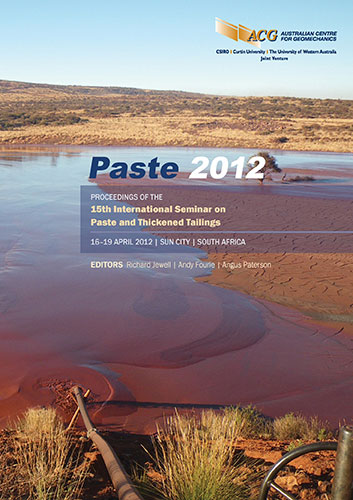Transport pilot tests on thickened tailings to determine the effect of pumping distance on tailings sedimentation

|
Authors: Chacón, P; Barrera, S |
DOI https://doi.org/10.36487/ACG_rep/1263_28_Chacon
Cite As:
Chacón, P & Barrera, S 2012, 'Transport pilot tests on thickened tailings to determine the effect of pumping distance on tailings sedimentation', in R Jewell, AB Fourie & A Paterson (eds), Paste 2012: Proceedings of the 15th International Seminar on Paste and Thickened Tailings, Australian Centre for Geomechanics, Perth, pp. 333-342, https://doi.org/10.36487/ACG_rep/1263_28_Chacon
Abstract:
The extreme aridness of northern Chile makes tailings processes in the region have, as one of their main objectives, the recovery of most of the water used in the concentration process before the slurry is discharged in the tailings impoundment. A way of reaching this objective is to increase the degree of thickening using current technology. However, in such a scenario, the transport of tailings with high solids content is a limiting factor in the hydraulic design of the global management system since it is a challenge to ensure that the slurry does not settle out in transport systems longer than 2 km. This is why it is imperative to study the behaviour of the transport systems of highly thickened tailings. In the Cerro Negro Norte Project, a technical-economic analysis was prepared for several options of tailings thickening and transport between the plant and the impoundment (Barrera and Hills, 2009) using centrifugal pumps which considered the execution of pilot tests in a pumping loop. The first stage of the tests had the objective of validating the theoretical hydraulic model used in the design of the thickened tailings pumping and determining the maximum level of thickening that may be pumped with centrifugal pumps. The second stage consisted in operating the pumping loop for a longer period to detect the effect of the transport distance in the sedimentation of the tailings. The purpose of this paper is to: (i) present the main results of the long term pilot tests done with thickened tailings in conditions of laminar flow; (ii) compare the recorded results with the theoretical models; (iii) analyse and interpret the main variations in time detected in the behaviour of the pumping loop; and (iv) provide comments and design recommendations for these types of projects.
References:
Barrera, S. and Hills, R. (2009) Cerro Negro — Assessment of Beach Slope and Indetermination of the Operational Limits of Centrifugal Pumps, in Proceedings 12th International Seminar on Paste and Thickened Tailings (Paste09), R.J. Jewell,
A.B. Fourie, S. Barrera, J. Wiertz (eds), 21–24 April 2009, Viña Del Mar, Chile, Gecamin Limited, Santiago, Australian Centre for Geomechanics, Perth, pp. 337–344.
Haldenwang, R. (2003) Flow of Non-Newtonian Fluids in Open Channels, Dissertation submitted in fulfilment of the degree Doctor Technology in the Department of Civil Engineering Cape Technikon.
McElvain, R.E. and Cave, I. (1972) Transportation of Tailings in Tailing Disposal Today, in Proceedings First International Tailings Symposium. C.L. Aplin and George O. Argall (eds), 31 October–3 November, Tucson, Arizona, USA, Miller Freeman Publications, Vol.1, pp. 164–202.
Rayo, J.C. (1993) Hydraulic Transportation of Solids Over Long Distances (in Spanish), Course given for the Peruvian Mining Society, Lima, Perú.
Thomas, A.D. and Wilson, K.C. (1987) New analysis of Non-Newtonian Turbulent Flow Yield-Power-Law Fluids, The Canadian Journal of Chemical Engineering, Vol. 65, pp. 335–338.
Wilson, K.C. and Thomas, A.D. (1985) A new analysis of the turbulent flow of non-Newtonian fluids, The Canadian Journal of Chemical Engineering, Vol. 63, pp. 539–546.
© Copyright 2025, Australian Centre for Geomechanics (ACG), The University of Western Australia. All rights reserved.
View copyright/legal information
Please direct any queries or error reports to repository-acg@uwa.edu.au
View copyright/legal information
Please direct any queries or error reports to repository-acg@uwa.edu.au